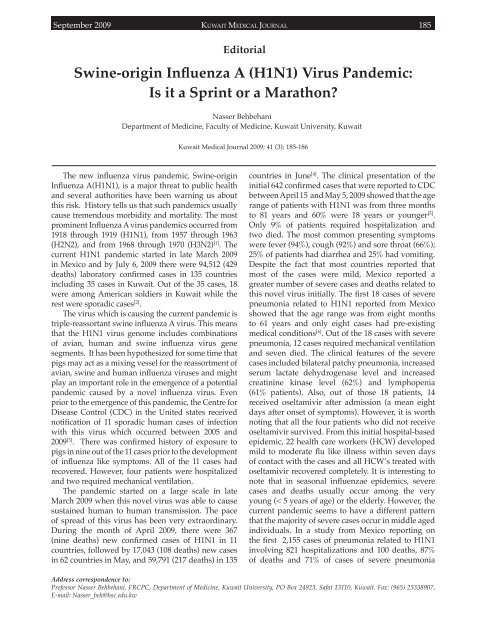Vol 41 # 3 September 2009 - Kma.org.kw
Vol 41 # 3 September 2009 - Kma.org.kw
Vol 41 # 3 September 2009 - Kma.org.kw
Create successful ePaper yourself
Turn your PDF publications into a flip-book with our unique Google optimized e-Paper software.
<strong>September</strong> <strong>2009</strong><br />
KUWAIT MEDICAL JOURNAL 185<br />
Editorial<br />
Swine-origin Influenza A (H1N1) Virus Pandemic:<br />
Is it a Sprint or a Marathon<br />
Nasser Behbehani<br />
Department of Medicine, Faculty of Medicine, Kuwait University, Kuwait<br />
Kuwait Medical Journal <strong>2009</strong>; <strong>41</strong> (3): 185-186<br />
The new influenza virus pandemic, Swine-origin<br />
Influenza A(H1N1), is a major threat to public health<br />
and several authorities have been warning us about<br />
this risk. History tells us that such pandemics usually<br />
cause tremendous morbidity and mortality. The most<br />
prominent Influenza A virus pandemics occurred from<br />
1918 through 1919 (H1N1), from 1957 through 1963<br />
(H2N2), and from 1968 through 1970 (H3N2) [1] . The<br />
current H1N1 pandemic started in late March <strong>2009</strong><br />
in Mexico and by July 6, <strong>2009</strong> there were 94,512 (429<br />
deaths) laboratory confirmed cases in 135 countries<br />
including 35 cases in Kuwait. Out of the 35 cases, 18<br />
were among American soldiers in Kuwait while the<br />
rest were sporadic cases [2] .<br />
The virus which is causing the current pandemic is<br />
triple-reassortant swine influenza A virus. This means<br />
that the H1N1 virus genome includes combinations<br />
of avian, human and swine influenza virus gene<br />
segments. It has been hypothesized for some time that<br />
pigs may act as a mixing vessel for the reassortment of<br />
avian, swine and human influenza viruses and might<br />
play an important role in the emergence of a potential<br />
pandemic caused by a novel influenza virus. Even<br />
prior to the emergence of this pandemic, the Centre for<br />
Disease Control (CDC) in the United states received<br />
notification of 11 sporadic human cases of infection<br />
with this virus which occurred between 2005 and<br />
<strong>2009</strong> [3] . There was confirmed history of exposure to<br />
pigs in nine out of the 11 cases prior to the development<br />
of influenza like symptoms. All of the 11 cases had<br />
recovered. However, four patients were hospitalized<br />
and two required mechanical ventilation.<br />
The pandemic started on a large scale in late<br />
March <strong>2009</strong> when this novel virus was able to cause<br />
sustained human to human transmission. The pace<br />
of spread of this virus has been very extraordinary.<br />
During the month of April <strong>2009</strong>, there were 367<br />
(nine deaths) new confirmed cases of H1N1 in 11<br />
countries, followed by 17,043 (108 deaths) new cases<br />
in 62 countries in May, and 59,791 (217 deaths) in 135<br />
countries in June [4] . The clinical presentation of the<br />
initial 642 confirmed cases that were reported to CDC<br />
between April 15 and May 5, <strong>2009</strong> showed that the age<br />
range of patients with H1N1 was from three months<br />
to 81 years and 60% were 18 years or younger [5] .<br />
Only 9% of patients required hospitalization and<br />
two died. The most common presenting symptoms<br />
were fever (94%), cough (92%) and sore throat (66%);<br />
25% of patients had diarrhea and 25% had vomiting.<br />
Despite the fact that most countries reported that<br />
most of the cases were mild, Mexico reported a<br />
greater number of severe cases and deaths related to<br />
this novel virus initially. The first 18 cases of severe<br />
pneumonia related to H1N1 reported from Mexico<br />
showed that the age range was from eight months<br />
to 61 years and only eight cases had pre-existing<br />
medical conditions [6] . Out of the 18 cases with severe<br />
pneumonia, 12 cases required mechanical ventilation<br />
and seven died. The clinical features of the severe<br />
cases included bilateral patchy pneumonia, increased<br />
serum lactate dehydrogenase level and increased<br />
creatinine kinase level (62%) and lymphopenia<br />
(61% patients). Also, out of those 18 patients, 14<br />
received oseltamivir after admission (a mean eight<br />
days after onset of symptoms). However, it is worth<br />
noting that all the four patients who did not receive<br />
oseltamivir survived. From this initial hospital-based<br />
epidemic, 22 health care workers (HCW) developed<br />
mild to moderate flu like illness within seven days<br />
of contact with the cases and all HCW’s treated with<br />
oseltamivir recovered completely. It is interesting to<br />
note that in seasonal influenzae epidemics, severe<br />
cases and deaths usually occur among the very<br />
young (< 5 years of age) or the elderly. However, the<br />
current pandemic seems to have a different pattern<br />
that the majority of severe cases occur in middle aged<br />
individuals. In a study from Mexico reporting on<br />
the first 2,155 cases of pneumonia related to H1N1<br />
involving 821 hospitalizations and 100 deaths, 87%<br />
of deaths and 71% of cases of severe pneumonia<br />
Address correspondence to:<br />
Professor Nasser Behbehani, FRCPC, Department of Medicine, Kuwait University, PO Box 24923, Safat 13110, Kuwait. Fax: (965) 25338907,<br />
E-mail: Nasser_beh@hsc.edu.<strong>kw</strong>
















